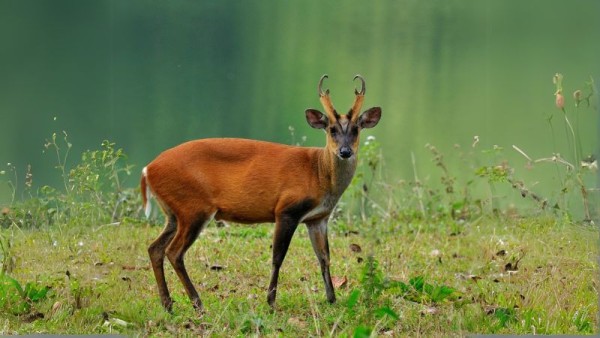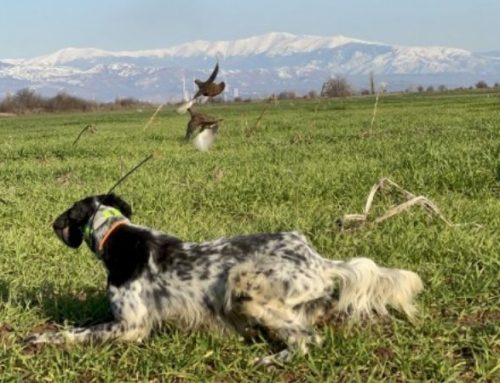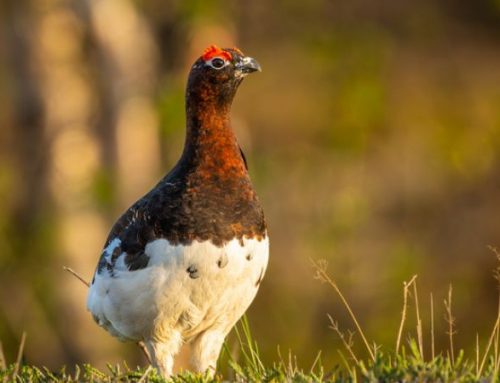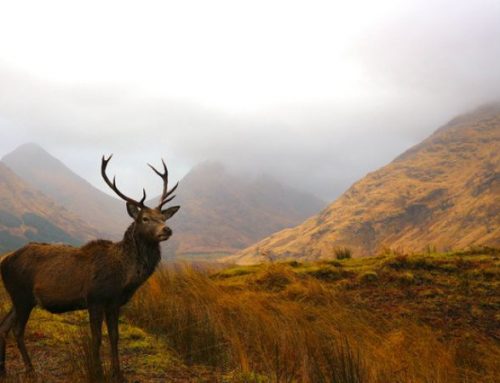Small, elusive, and fascinating: the Muntjac (or “barking deer”) is one of the most curious and lesser-known game species hunted in the UK.
Originally from Asia and introduced to England in the late 19th century, Muntiacus reevesi has successfully established itself in the English countryside, becoming an invasive non-native species. Today, the Muntjac is considered a huntable game animal year-round, with clear regulations and an ever-expanding population.
Origin and Characteristics of the Muntjac
Reeves’ Muntjac originally comes from China and Taiwan. Small in size, it stands about 40–50 cm at the shoulder and weighs between 10 and 18 kg. Males possess small, unbranched antlers and long, protruding upper canines, earning it the nickname “vampire deer.” Its vocalization, similar to a bark, has given it the common name “barking deer.
Highly Adaptable and Expanding Territory
Highly adaptable, the Muntjac has primarily settled in southern England and the Midlands, but its range is steadily expanding northward. It moves lightly through the undergrowth, elusive and silent like a shadow. Spotting it requires patience, keen observation, and a deep connection with the environment.
Legal Status and Hunting Management
In the UK, the Muntjac is classified as an invasive non-native species. As a result, there is no closed hunting season—it can be hunted year-round, provided the necessary permits are obtained and animal welfare regulations are respected. Muntjac hunting is part of many environmental management programs, with selective culling aimed at mitigating its impact on the local ecosystem, including damage to undergrowth, bird nests, and forest regeneration.
Hunting Areas
Muntjac populations are well established across many regions of England. The main hunting areas include:
-
East Anglia: Particularly in the counties of Norfolk, Suffolk, and Cambridgeshire, where large woodlands and well-managed private reserves offer excellent opportunities.
-
Buckinghamshire and Bedfordshire: Known for organized hunts on private estates, often guided by experienced local outfitters.
-
Oxfordshire, Hertfordshire, and Berkshire: These regions are rich in undergrowth, making them excellent for Muntjac stalking.
-
Warwickshire, Northamptonshire, and Leicestershire: Areas where the species has successfully established itself, allowing for productive short hunting outings.
-
Gloucestershire and Herefordshire: Ideal locations for combined hunts that include roe deer and fallow deer.
Hunting Methods and Approach
Muntjac hunting is considered a technical, silent, and highly focused activity. It is perfect for those who enjoy an individual approach and selective hunting. The main techniques include:
-
Individual Stalking: The most common method. Hunts take place at dawn or dusk, silently following trails through forests and field edges. This approach requires attention to detail, tracking skills, and the effective use of binoculars.
When and Where to Hunt Muntjac
Period: All year round
Best areas: Southeast England, Midlands, private woodland areas
Many hunting reserves and land managers in England offer Muntjac hunting packages, often in combination with Roe deer or Fallow deer. Some lodges also offer the possibility to complete the experience with tastings, overnight stays in historic cottages, and moments of relaxation in nature.
Gastronomic Value and Trophies
Muntjac meat is highly appreciated: tender, with a delicate flavor, perfect for roasts, stews, or slow cooking. The trophies, although modest, are highly sought after by collectors for the unique characteristics of the antlers and the male’s canines.
TECHNICAL SHEET – MUNTJAC HUNTING
Scientific name: Muntiacus reevesi
Common name: Reeves’ Muntjac / Barking Deer
Distribution: South and Midlands of the United Kingdom
Legal status: Invasive species – Huntable all year round
Recommended Hunting Techniques:
-
Twilight ambush
-
Woodland stalking
-
Tracking with a blood-trailing dog (if wounded)
Recommended Calibers:
-
.243 Win
-
.223 Rem
-
.22-250 Rem
-
.30-06 (light load)
Recommended Period:
All year round (best results in autumn and winter)
Required Licenses:
-
Firearms Certificate (FAC)
-
Permits for private land
-
Possibly guided hunting with a licensed guide
Hunting difficulty: Medium/High (elusive and fast-moving game)
Trophy value: Simple antlers + prominent canines (only in males)
Gastronomic value: Very good – fine and delicate meat
For hunters seeking a new challenge in the heart of the English countryside, the Muntjac represents an original, sustainable, and captivating prey. A technical, intimate, and always different hunt, to be experienced in the deep silence of England’s misty forests, where every rustle may announce an encounter with one of the most fascinating creatures of European wildlife.











